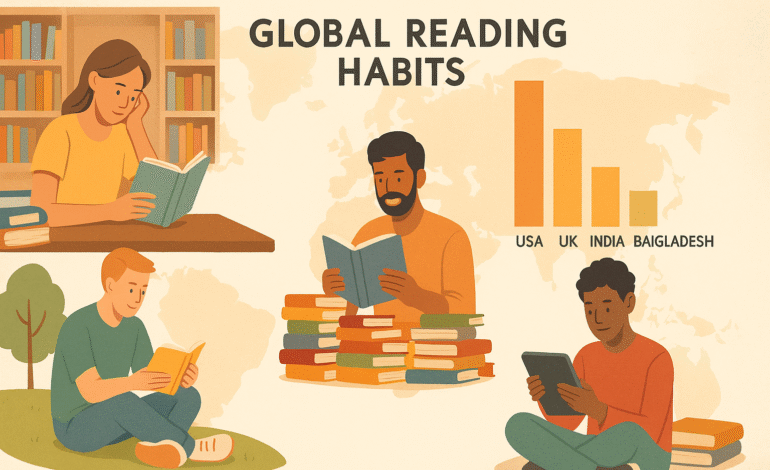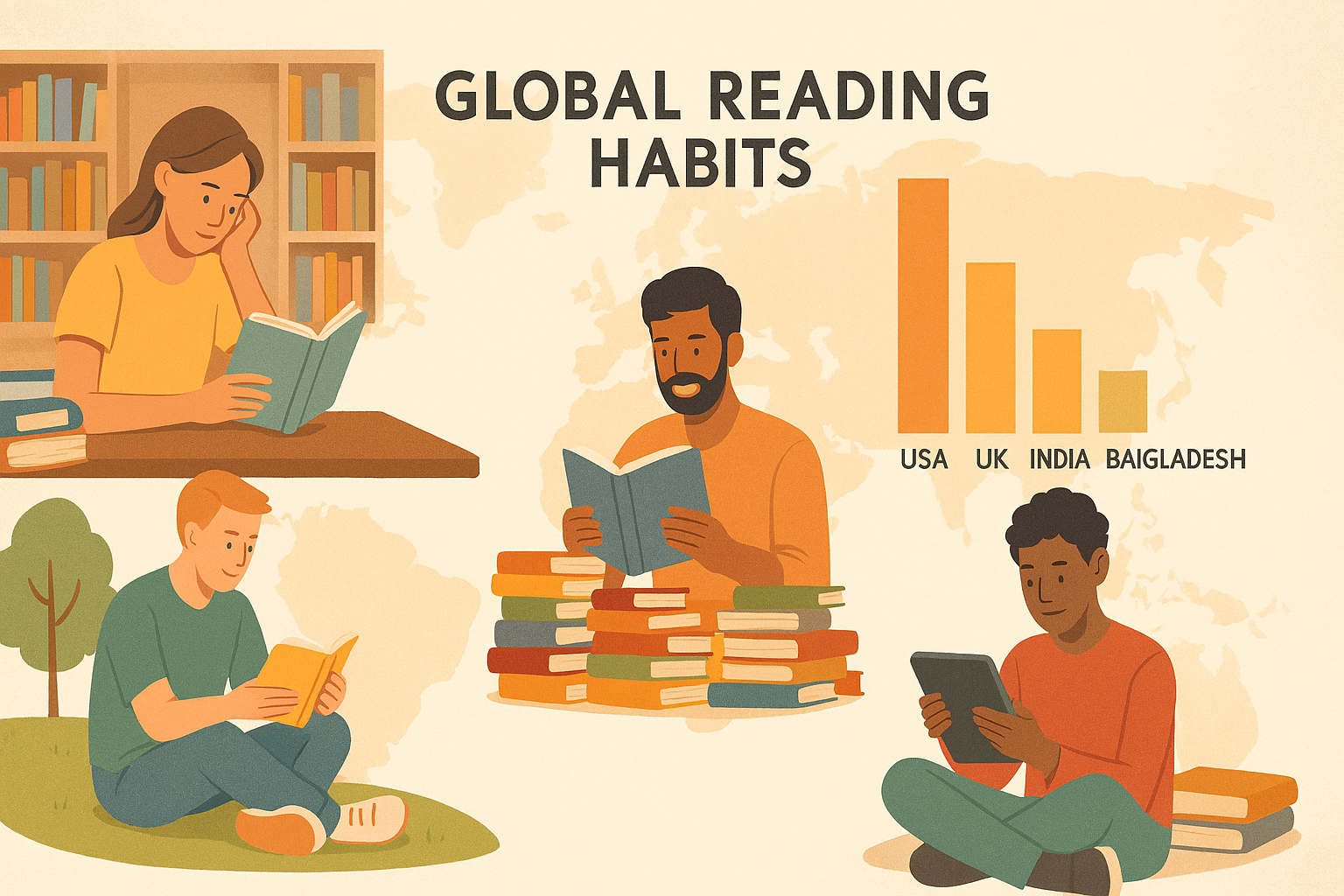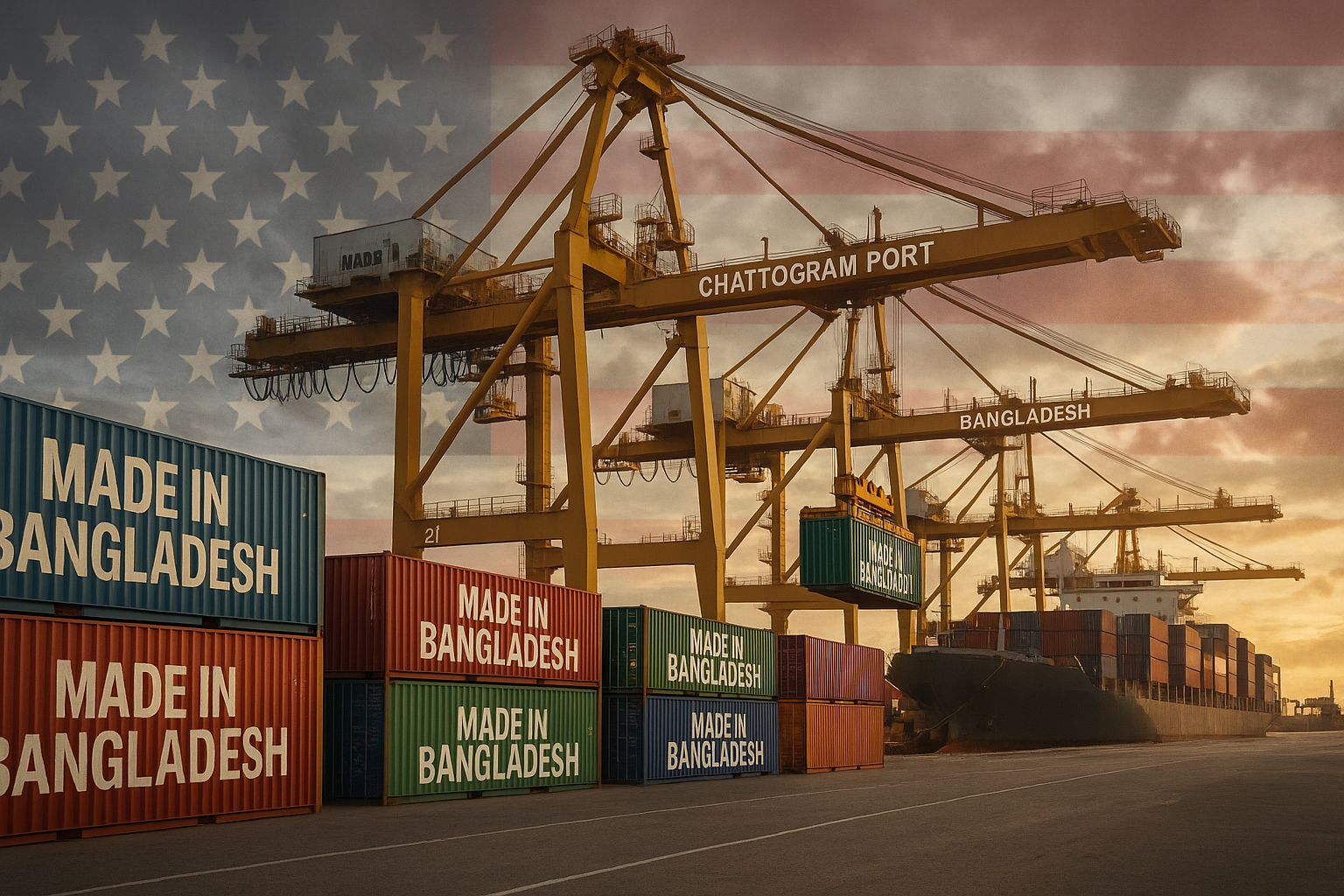Americans Read the Most Books While Bangladesh Ranks Lowest

A Global Look at Reading Culture
In a world increasingly dominated by short videos and social media snippets, the simple act of reading a book remains one of humanity’s most profound and transformative habits. Reading not only enhances knowledge but also shapes empathy, creativity, and global awareness. Yet, new data reveals a striking imbalance across nations: Americans lead the world in time spent reading, while Bangladesh ranks at the very bottom.
Global Reading Trends in 2025
The number of hours people from different countries spen reading each year:
Country| Hours Spent Reading Per Year
United States| 357 hours
India| 352 hours
United Kingdom| 343 hours
France| 305 hours
Italy| 278 hours
Bangladesh| 6 hours
This global snapshot offers a revealing view of how cultural, educational, and economic factors influence reading habits. The United States and India, both with vast publishing industries and strong literacy campaigns, remain global leaders in book consumption. In contrast, Bangladesh’s position—only six hours of reading per year on average—underscores deep-rooted challenges in literacy development and reading culture.
Why the U.S. Leads the World in Reading
Americans spend an average of 357 hours a year reading, which equates to nearly an hour per day. Several factors contribute to this high ranking:
1. Access to Books and Libraries: The U.S. has a well-developed library system and a robust publishing industry. E-books, audiobooks, and public library programs have made reading more accessible than ever.
2. Cultural Value of Reading: Reading is integrated into American education and leisure. Book clubs, reading challenges, and national campaigns such as “Read Across America” encourage lifelong learning.
3. Digital Integration: With platforms like Kindle and Audible, technology complements rather than replaces reading. This hybrid ecosystem keeps readers engaged.
India: A Rising Reading Powerhouse
India ranks second with 352 hours of reading per year, reflecting a vibrant literary scene. Despite economic disparities, India’s multilingual publishing market continues to grow, offering millions of affordable titles in English and regional languages.
Educational competitiveness also plays a role. The emphasis on exams and higher education drives a large portion of India’s population to spend hours reading textbooks, newspapers, and online materials. Moreover, the rise of digital literacy and book fairs in cities like Kolkata and Delhi have further boosted reading engagement.
Europe’s Consistent Reading Culture
Europe shows consistent reading patterns, with the United Kingdom (343 hours), France (305 hours), and Italy (278 hours) maintaining strong reading traditions.
– The United Kingdom has a deep-rooted literary heritage and one of the world’s largest book markets. Reading remains a key part of education and daily life.
– France emphasizes intellectual discourse, with bookstores, literary cafés, and national reading initiatives supporting an enduring culture of literature.
– Italy, though lower than its European counterparts, still maintains high levels of readership through schools, community libraries, and local publishing.
These nations demonstrate how policy, access, and cultural appreciation sustain reading as both an educational and recreational pursuit.
Bangladesh: A Stark Contrast
At the opposite end of the spectrum, Bangladesh records only six hours of reading per year—a figure that highlights a serious gap in reading engagement. Several factors contribute to this:
1. Limited Reading Infrastructure: Many areas still lack sufficient libraries, bookshops, and reading spaces, particularly outside major cities.
2. Economic Constraints: For a large portion of the population, reading books for leisure remains secondary to economic survival.
3. Digital Distraction: Like elsewhere, the growing influence of social media has replaced long-form reading with shorter digital content.
4. Language and Availability: Although Bengali literature has a rich heritage, the modern publishing industry struggles to compete with imported digital entertainment.
Despite these challenges, initiatives such as Ekushey Book Fair, community reading programs, and digital literacy projects are slowly reviving interest among younger generations.
Global Relevance: Reading in the Digital Age
The global reading gap mirrors broader inequalities in education, income, and access to information. In wealthier nations, reading often aligns with cultural status and intellectual growth. In developing nations, it is tied more closely to survival needs and limited educational infrastructure.
However, technology has begun bridging this divide. The rise of audiobooks, e-learning platforms, and mobile reading apps has made literature more accessible to remote communities. Global organizations such as UNESCO and World Literacy Foundation are also promoting literacy programs to encourage regular reading among youth and adults alike.
Why Reading Still Matters
In a time dominated by instant updates and algorithm-driven feeds, reading remains one of the few activities that cultivates deep focus and empathy. Studies have consistently shown that reading books improves memory, concentration, and emotional intelligence. Moreover, it fosters global understanding—allowing readers to experience different cultures, ideas, and perspectives through words.
For developing countries like Bangladesh, investing in reading is more than a cultural pursuit—it is a pathway to empowerment. A strong reading culture can fuel innovation, civic engagement, and sustainable development.
The Way Forward
To close the global reading gap, several strategies could make a lasting impact:
– Expand Public Libraries: Building accessible libraries across rural and urban areas can nurture lifelong reading habits.
– Promote Local Literature: Encouraging writing and publishing in native languages can connect readers with relatable stories.
– Integrate Reading into Education: Schools must emphasize reading not just as a subject but as a daily habit.
– Use Digital Platforms: Affordable e-books and mobile reading apps can reach millions who lack physical books.
– Host National Reading Campaigns: Events and book fairs can inspire both youth and adults to rediscover the joy of reading.
Conclusion
Reading remains the cornerstone of intellectual and social growth. The latest data showing the United States and India as top readers, while Bangladesh ranks last, reflects more than numbers—it reveals the global divide in access to knowledge and culture.
Yet, with technology, education, and cultural reform, countries with lower reading rates can transform their future. A society that reads is a society that thinks, questions, and grows.
And in that transformation lies the promise of a more informed, equitable, and connected world.







